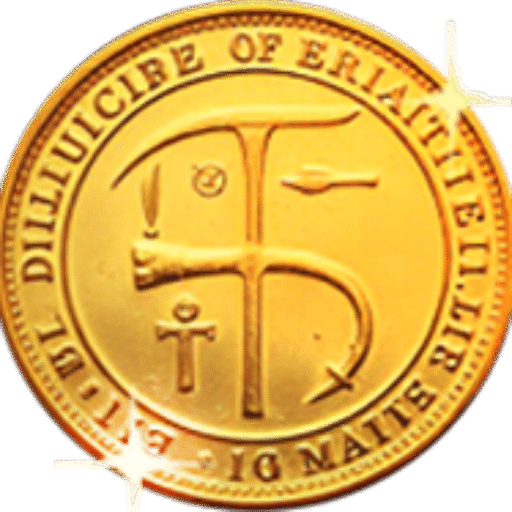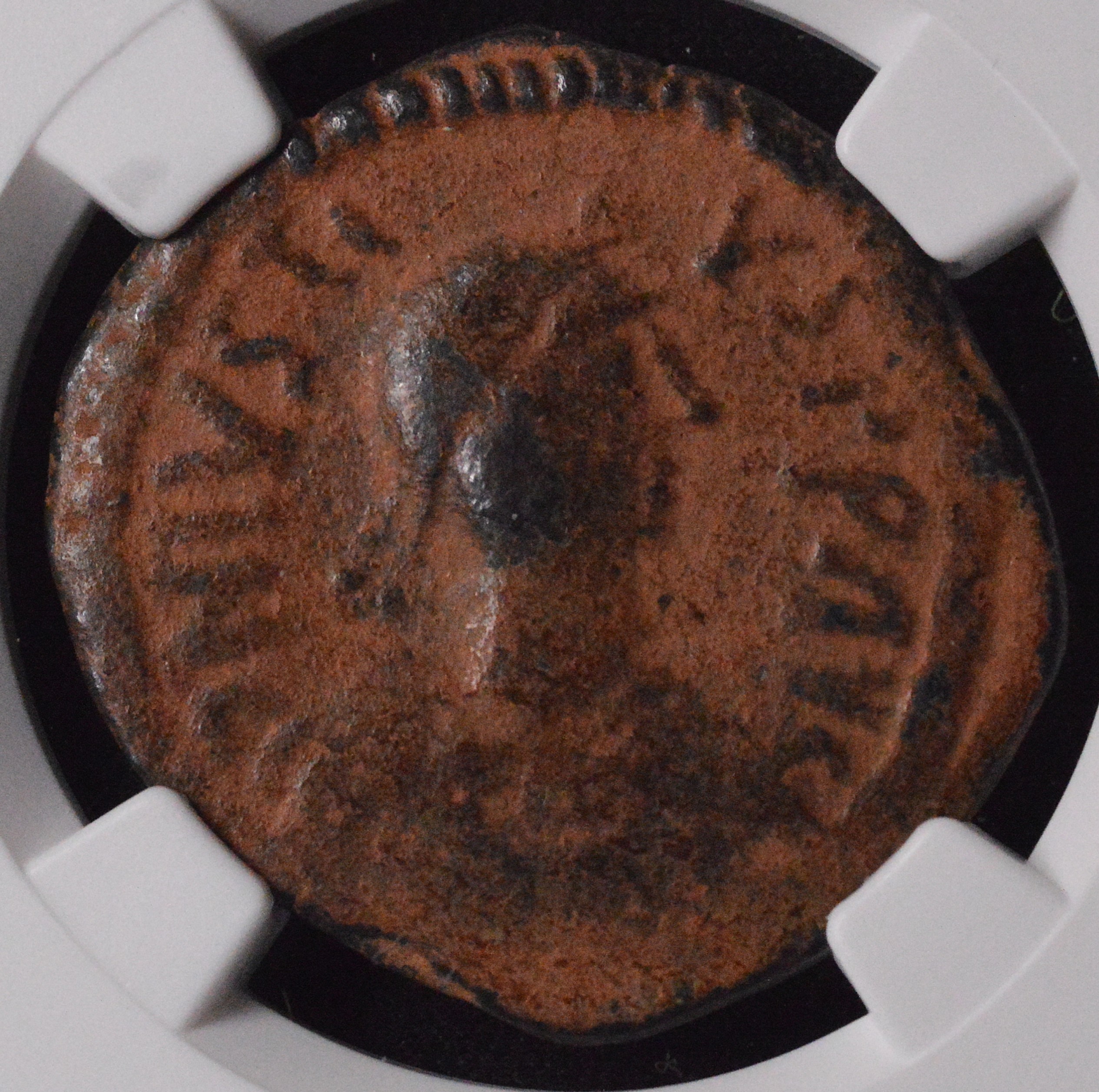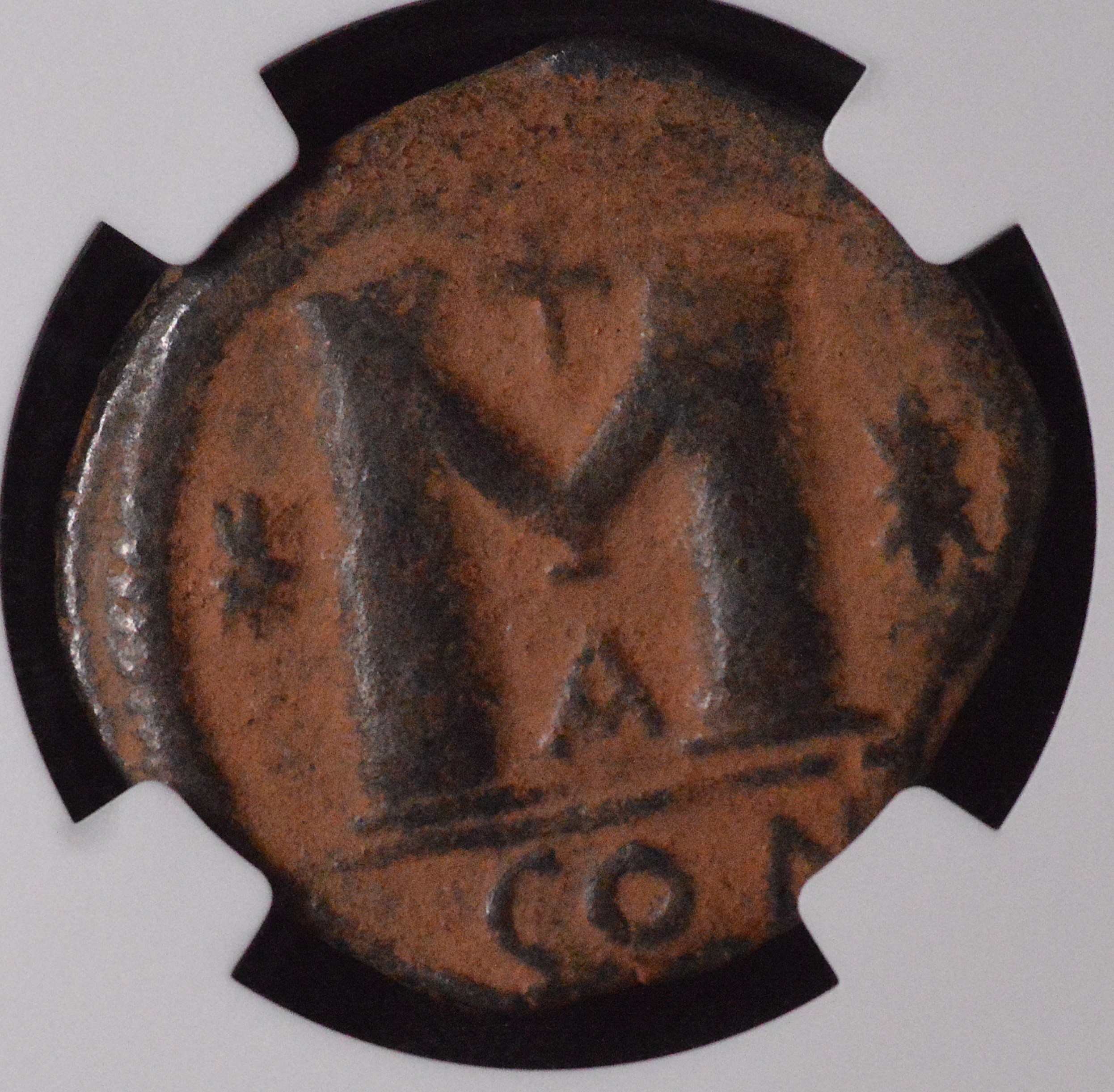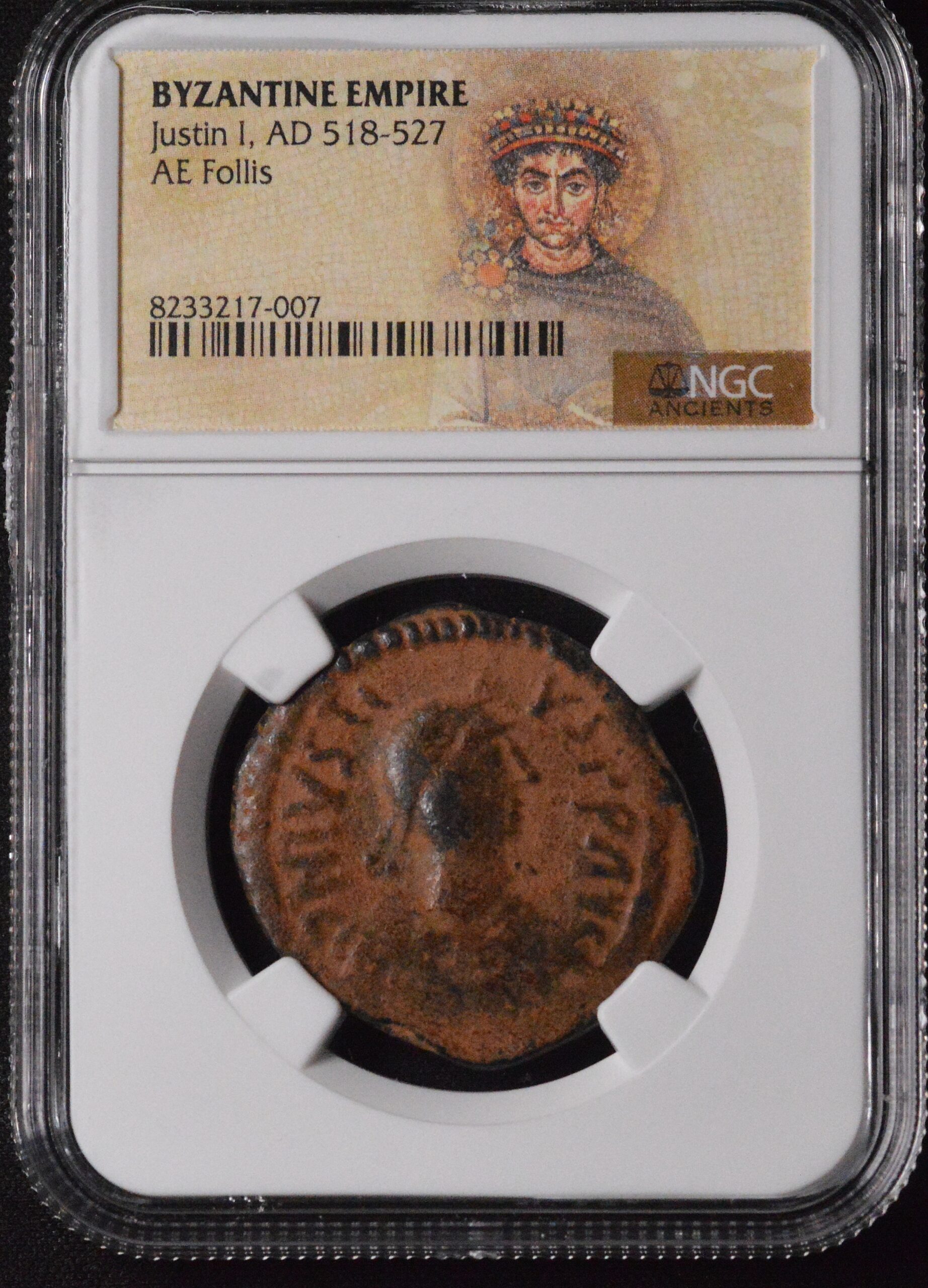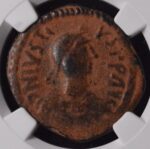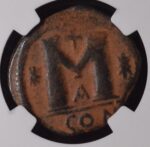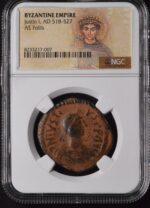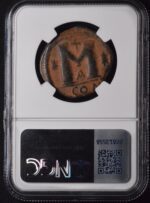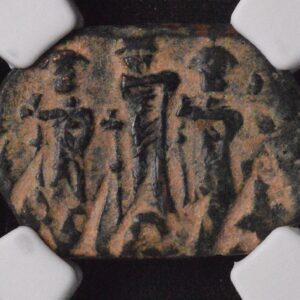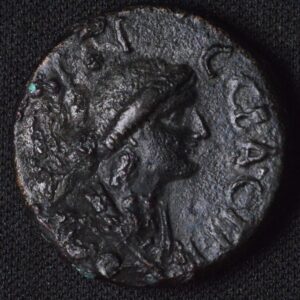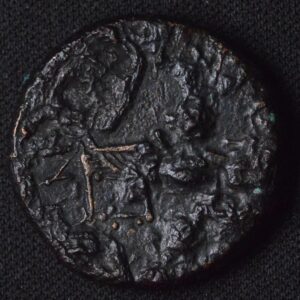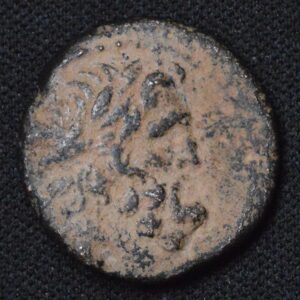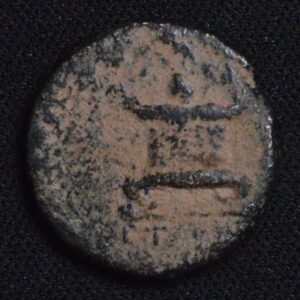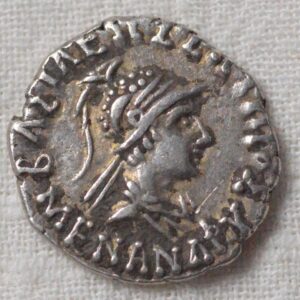FREE SHIPPING
Free Shipping for Orders over $150
Description
This VERY RARE Byzantine AE Follis of Justin I, who ruled from AD 518 to 527, is a prized and historically significant example from the early Byzantine era. Coins from Justin I’s reign are highly sought after, especially in beautiful condition with attractive patina. The AE (bronze) follis served as a large denomination coin and represented a major step in the evolution of Byzantine coinage, transitioning away from late Roman forms and establishing new imperial imagery.
Typically, the obverse of a Justin I follis features a bold portrait of the emperor, often shown facing front and wearing a diademed or helmeted bust, with imperial attire. The reverse generally displays a large “M”—the denomination mark for follis—accompanied by inscriptions indicating the regnal year, mint mark (such as CON for Constantinople), and sometimes Christian symbols like a cross. These coins showcase the early Byzantine style, with strong, blocky portraits and distinctive lettering, making them unmistakable among collectors and historians.
NGC certification guarantees the authenticity and proper identification of the coin, and having “beautiful patina and great condition” means this follis possesses not only clear details and legible inscriptions but also the rich coloration and natural aging that collectors value. Such well-preserved pieces from Justin I’s short but impactful reign are uncommon on the market, adding to their desirability and status as standout centerpieces in ancient or Byzantine coin collections.
Coins of Justin I are especially important for their connections to the transition between the late Roman and early Byzantine Empires. His reign set the stage for his famous nephew, Justinian I, who would follow and usher in a golden era of Byzantine culture and expansion. As a result, the coins of Justin I are foundational artifacts for anyone interested in Byzantine history or early medieval numismatics.
This rare and appealing AE Follis, certified by NGC, offers a chance to own a tangible piece of early Byzantine history—an artifact of imperial reform, religious change, and the enduring legacy of the Eastern Roman Empire. Its rarity, condition, and historical significance make it a coveted acquisition for discerning collectors.
This VERY RARE Byzantine AE Follis of Justin I, who ruled from AD 518 to 527, is a prized and historically significant example from the early Byzantine era. Coins from Justin I’s reign are highly sought after, especially in beautiful condition with attractive patina. The AE (bronze) follis served as a large denomination coin and represented a major step in the evolution of Byzantine coinage, transitioning away from late Roman forms and establishing new imperial imagery.
Typically, the obverse of a Justin I follis features a bold portrait of the emperor, often shown facing front and wearing a diademed or helmeted bust, with imperial attire. The reverse generally displays a large “M”—the denomination mark for follis—accompanied by inscriptions indicating the regnal year, mint mark (such as CON for Constantinople), and sometimes Christian symbols like a cross. These coins showcase the early Byzantine style, with strong, blocky portraits and distinctive lettering, making them unmistakable among collectors and historians.
NGC certification guarantees the authenticity and proper identification of the coin, and having “beautiful patina and great condition” means this follis possesses not only clear details and legible inscriptions but also the rich coloration and natural aging that collectors value. Such well-preserved pieces from Justin I’s short but impactful reign are uncommon on the market, adding to their desirability and status as standout centerpieces in ancient or Byzantine coin collections.
Coins of Justin I are especially important for their connections to the transition between the late Roman and early Byzantine Empires. His reign set the stage for his famous nephew, Justinian I, who would follow and usher in a golden era of Byzantine culture and expansion. As a result, the coins of Justin I are foundational artifacts for anyone interested in Byzantine history or early medieval numismatics.
This rare and appealing AE Follis, certified by NGC, offers a chance to own a tangible piece of early Byzantine history—an artifact of imperial reform, religious change, and the enduring legacy of the Eastern Roman Empire. Its rarity, condition, and historical significance make it a coveted acquisition for discerning collectors.
This VERY RARE Byzantine AE Follis of Justin I, who ruled from AD 518 to 527, is a prized and historically significant example from the early Byzantine era. Coins from Justin I’s reign are highly sought after, especially in beautiful condition with attractive patina. The AE (bronze) follis served as a large denomination coin and represented a major step in the evolution of Byzantine coinage, transitioning away from late Roman forms and establishing new imperial imagery.
Typically, the obverse of a Justin I follis features a bold portrait of the emperor, often shown facing front and wearing a diademed or helmeted bust, with imperial attire. The reverse generally displays a large “M”—the denomination mark for follis—accompanied by inscriptions indicating the regnal year, mint mark (such as CON for Constantinople), and sometimes Christian symbols like a cross. These coins showcase the early Byzantine style, with strong, blocky portraits and distinctive lettering, making them unmistakable among collectors and historians.
NGC certification guarantees the authenticity and proper identification of the coin, and having “beautiful patina and great condition” means this follis possesses not only clear details and legible inscriptions but also the rich coloration and natural aging that collectors value. Such well-preserved pieces from Justin I’s short but impactful reign are uncommon on the market, adding to their desirability and status as standout centerpieces in ancient or Byzantine coin collections.
Coins of Justin I are especially important for their connections to the transition between the late Roman and early Byzantine Empires. His reign set the stage for his famous nephew, Justinian I, who would follow and usher in a golden era of Byzantine culture and expansion. As a result, the coins of Justin I are foundational artifacts for anyone interested in Byzantine history or early medieval numismatics.
This rare and appealing AE Follis, certified by NGC, offers a chance to own a tangible piece of early Byzantine history—an artifact of imperial reform, religious change, and the enduring legacy of the Eastern Roman Empire. Its rarity, condition, and historical significance make it a coveted acquisition for discerning collectors.
CUSTOMER FEEDBACK








Other Products to See
Heraclius Constantine and Martina, AD 610-641 AE, NGC Certified Authentic
$350.00Augusta AE22 CEBACTI Zeus Seated Reverse Ancient Coin Very Nice Condition
$289.00Antioch (Seleukis & Pieria) AE18 Zeus & Garlanded Altar Ancient Coin
$289.00



SHIPPING POLICY
Your order is shipped from the United States with USPS tracking within one business day.
14 Day Return Policy
You can return your item back within
14 days of the purchase

Secure payments
Your payments are 100% secure and are processed through Square or PayPal on a protected security network.
SHIPPING POLICY
FREE International and Domestic (United States) shipping. Your order is shipped with USPS tracking 24 hours after you order.
14 Day Return Policy
You can return your item back within
14 days of the purchase

Secure payments
Your payments are 100% secure and are processed through Square or PayPal on a protected security network.
RESOURCES
support
Get Fresh Articles!
Sign up now to receive our articles for the latest insights and promotions!
RESOURCES
support
Get Fresh Articles!
Signup our newsletter to get update insight or promotions.

